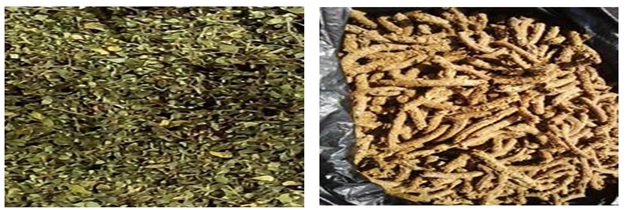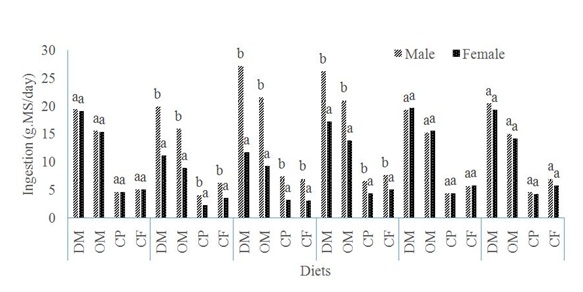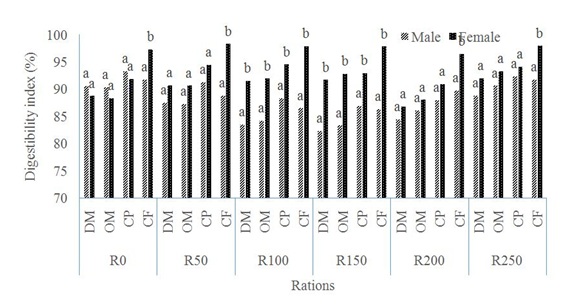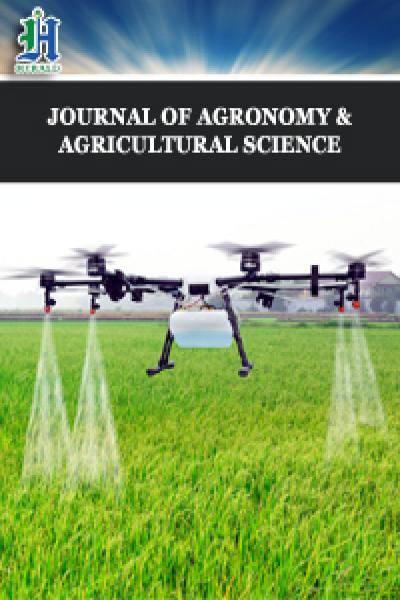
Effect of Fertilization Level on Chemical Composition, intake and Digestibility in vivo of Moringa oleifera Cutting at 6 Months in Guinea Pig
*Corresponding Author(s):
Fernand TendonkengDepartement Des Productions Animales, Laboratoire De Nutrition Animale, FASA, Université De Dschang, B.P. 222 , Dschang, Cameroon
Tel:+237 696804671,
Email:f.tendonkeng@univ-dschang.org
Abstract
Keywords
Caecal flora; Chemical composition, Guinea pigs, in vivo digestibility; Moringa oleifera.
INTRODUCTION
Food is the main factor limiting the expression of production potential tropical animals [1,2]. According to animals ingest food to meet their energy and nutrients [3]. Thus, the more food is able to release its nutrients, the better it allows achieving good animal performance at a lower cost as a result of the reduction in consumption. In addition, according to food consumption entirely of plant origin by herbivores slows digestion, and consequently allows a good absorption of food and a more favorable balance of nutrients by calories due to good cell growth management [4]. Thus, improving the productivity of monogastric herbivores like the guinea pig can be between others, by improving their diet and, above all, by making available to them fodder rich in protein. Among the alternative sources of high-protein forage in Cameroon, they are the plant of Moringa oleifera which, in addition to minerals contains vitamins in quantity important. The leaves of Moringa oleifera are an excellent source of protein whose grades range from 19-35% DM [5]. The amino acid content of the M. ofeifera leaf meal is not significantly different to that of soybean meal with a digestibility of 79.2% [6-8]. Its energy content metabolizable range from 2273-2978 kcal/Kg DM [7]. The leaves of M. oleifera contain a very high concentration of vitamins, A (6.8 mg), B (423 mg) and C (220 mg); in minerals (Iron, Calcium, Zinc, Selenium) and are rich in B-Carotene [9,10]. Despite this good protein content, the use of this plant in animal feed is not very popular. In addition, its chemical composition and digestibility vary according to geographical areas, fertilizer type, fertilization levels and age of mowing. The work of showed that Moringa oleifera fertilized at different doses urea (0, 30, 60, 90 and 120 kg/ha) affected their chemical composition [11]. Likewise, apparent digestive utilization coefficient of nutrients from M. ofeifera fertilized to poultry manure and cutting at 90 days was not significantly different in rabbits. These coefficients of use apparent digestive increased with the inclusion level of M. ofeifera (5 to 20%) [12]. On the other hand, the work of in Guatemala on degradation rumen of the dry matter and fibers of Cynodondactylon fertilized with different levels of nitrogen and harvested at two different dates, have shown that nitrogen fertilization improved the effective degradation of the dry matter and NDF for every 100 kg N/ha [13]. If the work was done in Cameroon on the fertilization of Moringa oleifera, none have yet been realized on the effect of different levels of fertilization and age of cutting on Moringa oleifera digestibility [14]. It is therefore to overcome this gap that the present work was initiated with the aim of evaluating the effect of fertilization level on the chemical composition, ingestion and digestibility of Moringa oleifera cutting at 6month in the guinea pig.
MATERIALS AND METHODS
Experimental site
Precipitations
Soil analysis
|
Parameters |
Values |
|
Depth |
0-20 cm |
|
Texture (%) |
|
|
Sand |
62 |
|
Total silt |
10 |
|
Clay |
28 |
|
Textural Class |
L |
|
Ground reaction |
|
|
Water-pH |
4.8 |
|
KCL-pH |
4 |
|
Organic matter |
|
|
CO (%) |
6.6 |
|
MO (%) |
11.35 |
|
Total N (g/kg) |
2.7 |
|
C/N |
22 |
|
Exchangeable cations (meq/100g) |
|
|
Calcium |
11 |
|
Magnésium |
3 |
|
Potassium |
0.7 |
|
Sodium |
0.08 |
|
Sum of Bases (SB) |
14.78 |
|
Cation exchange capacity |
|
|
CEC at pH7 |
46 |
|
Saturation in bases (%) |
32 |
|
Assimilated phosphorus |
|
|
Phosphorus Bray II |
21 |
Description, origin and chemical composition of the fertilizer source
|
Parameters |
Values |
|
Carbon (%) |
31 |
|
Organicmatter (%) |
53.1 |
|
Potassium (ppm) |
3382 |
|
Sodium (ppm) |
617 |
|
Phosphorus (ppm) |
911 |
|
Nitrogen (g/kg) |
24 |
Animal material
Plant material
Manufacture of Moringa oleifera
R0=200g fresh T.laxum + 3.46g dry M. oleifera leaves produced with 0kg.N/ha/animal/day;
R50=200g fresh T.laxum + 3.46g dry M. oleifera leaves produced at 50kg.N/ha/animal/day;
R100=200g fresh T.laxum + 3.46g dry M. oleifera leaves produced at 100 kg.N/ha/Animal/day;
R150=200g fresh T.laxum + 3.46g dry M. oleifera leaves produced at 150 kg.N/ha/Animal/day;
R200=200g fresh T.laxum + 3.46g dry M. oleifera leaves produced at 200 kg.N/ha/Animal/day;
R250=200g fresh T.laxum + 3.46g dry M. oleifera leaves produced at 250 kg.N/ha/Animal/day;

Evaluation of the chemical composition of Moringa oleifera
• Equation 1:NFE = DM-(CP+CF+Ash+Fat)
• Equation 2:Sugar = OM-(Fat+CP)
Evaluation of ingestion of Moringa oleifera
Evaluation of the digestibility of Moringa oleifera
Statistical analyzes
RESULTS AND DISCUSSION
Effect of fertilization level on the chemical composition of Moringa oleifera cutting at 6 months
The CP content had significantly (p <0.05) increased with fertilization up to 200 kg N/ha. These results are superior to those obtained by when he fertilized M. oleifera on cow bursaries and similar to those obtained by when they applied the increasing doses of urea and chicken droppings on the chemical composition of M. oleifera respectively [11,19,22,23]. Increasing the crude protein content of M. oleiferaunder the effect of nitrogen fertilization is accompanied by a decrease in protein nitrogen in favor of non-protein nitrogen. In fact, the entry of nitrogen into the plant, which takes place essentially in the form of nitrate, increases rapidly with fertilization, which leads in a first step to the accumulation of no-protein nitrogen, followed by nitrate for high fertilization levels [2,19,24].
The CP content of plots fertilized at 200 and 250 kg N/ha, however, remained not significantly different. The ash and fat contents of Moringa oleifera have varied with fertilization levels. The highest values for ash (8.33% DM) and fat (5.01% DM) were obtained with plants fertilized at 250 kg N/ha and unfertilized plants respectively. NFE and sugar of Moringa oleifera decreased with fertilization levels. Indeed, the results presented show significant variations whose nitrogen intensification is not the least cause. A decrease of 10 to 20% in the non-nitrogenous extract content of the forage is recorded as soon as one goes from a fertilization of 30 units to 90-120 units of nitrogen. It thus appears that the fodder obtained under these intensification conditions are less rich in non-nitrogen extractives, which does not imply that they are less energetic, because at the same time they are richer in nitrogenous matter. Likewise, the increase in nitrogen content following nitrogen fertilization is often associated with a decrease in the level of soluble carbohydrates (sugars), which are sometimes halved. This significant decrease results from the fact that the development of soluble carbohydrates, limited by leaf area and photosynthesis, is not increased by nitrogen fertilization, contrary to their use.Fertilization had no significant effect (p> 0.05) on the CF content of Moringa oleifera [25].
Effect of fertilization level on ingestion of Moringa oleifera cutting at 6 months in guinea pigs
| Ingestions (g DM/Day/animal) | Traitments | SEM | P | ||||||
| R0 | R50 | R100 | R150 | R200 | R250 | ||||
| Experimental diet | |||||||||
| M. oleifera(DM) | ?(5) | 22.13a | 22.53a | 30.93a | 29.73a | 21.93a | 24.53a | 1.43 | 0.25 |
| ?(5) | 21.73b | 12.60a | 13.26a | 19.46ab | 22.40b | 23.06b | 1.34 | 0.03 | |
| ??(10) | 21.93a | 17.56a | 22.09a | 24.59a | 22.16a | 23.79a | 1.38 | 0.14 | |
|
T. laxum(DM) |
?(5) |
140.00a |
134.73a |
143.00a |
144.26a |
148.60a |
140.26a |
3.27 |
0.92 |
|
?(5) |
137.93a |
138.80a |
119.06a |
128.46a |
133.40a |
127.26a |
3.96 |
0.77 |
|
|
??(10) |
138.96a |
136.76a |
131.03a |
136.36a |
141.00a |
133.76a |
3.62 |
0.84 |
|
|
Total Nutrients |
|||||||||
|
Dry Matter |
?(5) |
148.67a |
144.27a |
159.13a |
159.38a |
156.45a |
149.99a |
3.62 |
0.83 |
|
?(5) |
146.41a |
139.29a |
121.58a |
135.76a |
142.82a |
136.76a |
3.84 |
0.58 |
|
|
??(10) |
147.54a |
141.78a |
140.35a |
147.57a |
149.63a |
143.37a |
3.73 |
0.71 |
|
|
Organic Matter |
?(5) |
128.31a |
124.44a |
136.68a |
137.17a |
134.92a |
127.99a |
3.1 |
0.83 |
|
?(5) |
126.36a |
120.71a |
105.13a |
117.21a |
123.00a |
116.62a |
3.33 |
0.6 |
|
|
??(10) |
127.33a |
122.57a |
120.90a |
127.19a |
128.96a |
122.30a |
3.21 |
0.71 |
|
|
Crude Protein |
?(5) |
21.19a |
19.97a |
24.27a |
23.63a |
21.88a |
21.12a |
0.61 |
0.34 |
|
?(5) |
20.87a |
18.70a |
17.26a |
19.51a |
20.17a |
19.31a |
0.52 |
0.5 |
|
|
??(10) |
21.03a |
19.33a |
20.76a |
21.57a |
21.02a |
20.21a |
0.57 |
0.42 |
|
|
Crude Fiber |
?(5) |
58.27a |
57.37a |
61.28a |
62.41a |
62.12a |
59.38a |
1.38 |
0.9 |
|
?(5) |
57.39a |
56.20a |
48.23a |
53.79a |
56.46a |
54.08a |
0.55 |
0.64 |
|
|
??(10) |
57.83a |
56.78a |
54.75a |
58.10a |
59.29a |
56.73a |
0.96 |
0.77 |
|
Comparative effect of fertilization levels on ingested Moringa oleifera at 6 months between male and female

a, b: Bars with the same letters for the same ration are not significantly different at the 5% level; DM: Dry matter; OM: Organic matter; CP: Crude protein; CF: Crude fiber.
Effect of fertilization level on digestibility of Moringa oleifera nutrients cutting at 6 months in guinea pigs
|
Fertilization Level (kg N/ha) |
Chemical Composition (%DM) |
|||||||
|
DM |
OM |
Ash |
CP |
CF |
Fat |
NFE |
Sugar |
|
|
0 |
87.44b |
70.11b |
6.36a |
16.67a |
26.08a |
5.01c |
33.29d |
28.33c |
|
50 |
87.97b |
70.52b |
6.87bc |
21.63b |
31.00a |
2.56b |
25.89c |
27.72c |
|
100 |
87.43b |
69.40b |
7.05bc |
25.40c |
25.57a |
1.09a |
28.30c |
26.83c |
|
150 |
87.85b |
70.45b |
6.74ab |
29.11d |
28.94a |
2.39b |
20.66b |
24.92b |
|
200 |
87.51b |
69.30b |
7.29c |
32.99e |
29.30a |
1.11a |
16.75b |
22.56a |
|
250 |
83.28a |
61.31a |
8.33d |
32.69e |
29.65a |
1.77ab |
10.83a |
20.95a |
|
SEM |
0.404 |
0.8 |
0.157 |
1.44 |
0.673 |
0.333 |
1.88 |
0.684 |
|
p |
0 |
0 |
0 |
0 |
0.106 |
0 |
0 |
0 |
a, b, c, d, e: Mean with the same letters on the same column are not significantly different at the 5% level; SEM: Standard Error of the Mean; P: significance level; DM: dry matter; OM: organic matter; CP: crude protein; CF: crude fiber; ENA: Extractive non-nitrogenous.
|
Digestibility (%) |
Diets |
SEM |
p |
||||||
|
R0 |
R50 |
R100 |
R150 |
R200 |
R250 |
|
|
||
|
|
? |
90.55a |
87.51a |
83.49a |
82.35a |
84.47a |
88.81a |
0.97 |
0.06 |
|
DM |
? |
88.75a |
90.69a |
91.49a |
91.70a |
86.84a |
92.03a |
0.64 |
0.1 |
|
?? |
89.65a |
89.10a |
87.49a |
87.02a |
85.65a |
90.42a |
0.8 |
0.08 |
|
|
OM |
? |
90.37a |
87.29a |
84.25a |
83.34a |
86.10a |
90.65a |
0.91 |
0.06 |
|
? |
88.35a |
90.65a |
91.94a |
92.85a |
88.04a |
93.28a |
0.7 |
0.09 |
|
|
?? |
89.36a |
88.97a |
88.09a |
88.09a |
87.07a |
91.96a |
0.8 |
0.08 |
|
|
CP |
? |
93.22a |
91.25a |
88.30a |
86.93a |
87.97a |
92.39a |
0.79 |
0.06 |
|
? |
91.84a |
94.45a |
94.54a |
92.95a |
90.90a |
94.08a |
0.54 |
0.26 |
|
|
?? |
92.53a |
92.85a |
91.42a |
89.94a |
89.43a |
93.23a |
0.66 |
0.16 |
|
|
CF |
? |
91.73a |
88.82a |
86.53a |
86.36a |
89.73a |
91.76a |
0.74 |
0.09 |
|
? |
97.30a |
98.33a |
97.88a |
97.85a |
96.52a |
97.96a |
0.19 |
0.06 |
|
|
?? |
94.51a |
93.57a |
92.20a |
92.10a |
93.12a |
94.86a |
0.46 |
0.07 |
|
a, b: Averages with the same letters on the same line are not significantly different at the 5% level; SEM: Standard Error of Mean; P: significance level; R: Rations; DM: Dry matter; OM: Organic matter; CP: Crude protein; CF: Crude fiber.
comparative effect of fertility levels on Moringa Oleifera digestibility cutting at 6 months between male and female

a, b: Bars with the same letters for the same ration are not significantly different at the 5% level; Di: Digestibility; DM: Dry matter; OM: Organic matter; CP: Crude protein; CF: Crude fiber
CONCLUSION
REFERENCES
- Pamo TE, Boukila B, Fonteh FA, Tendonkeng F, Kana JR, et al. (2007) Nutritive values of some basic grasses and leguminous tree foliage of the central region of Africa. Animal Feed Science and Technology, 135: 273-282.
- Tendonkeng F, Boukila B, Pamo TE, Mboko AV, Zogang FB, et al. (2011) Effets direct et résiduel de différents niveaux de fertilisation azotée sur la composition chimique de Brachiaria ruziziensisà la floraison à l’Ouest Cameroun. International Journal of Biological and Chemical Sciences 5: 570-585.
- Meyer K, Hummel J, ClaussM (2010) The relationship between forage cell wall content and voluntary food in take in mammalian herbivores. Mammal Review. 40: 221-245.
- Niraj CB, Vardhan HB (2012) Impact of moringa leaves on erythrocytes maturation in a mammal Caviaporcellus. Indian Journal of Fundamental and Applied Life Sciences, 2: 26-29.
- Adeyinka SM, Oyedele OJ, Adeleke TO, Odedire JA (2008) Reproductive performance of rabbits fed Moringa oleifera as a replacement for Centrosemapubescens. Verona ,Italy.
- Bau HM, Villaume C, Lin CF, Evrard J, Quemener B, et al. (1994) Effect of a solid state fermentation using Rhizopus oligosporum sp. T-3 on elimination of antinutritional substances and modification of biochemical constituents of defatted rapeseeds meal. Journal of the Science of Food and Agriculture 65: 315-322.
- Makkar HPS, Becker K (1996) Nutritional value and antinutritional components of whole and ethanol extracted Moringa oleifera leaves. Anim Feed SciTechnol 63: 211-228.
- Ly J, Pok S, Preston TR (2001) Nutritional evaluation of tropical leaves for pigs: Pepsin/pancreatin digestibility of thirteen plant species. Livestock Research for Rural Development 13.
- Fuglie LJ (2002) Nutrition naturelle sous les tropiques (105-118) In : L’arbre de la vie, Les multiples usages du Moringa.-Wageningen : CTA; Dakar: CWS.-177p.
- Mbora A, Mundia G, Muasya S (2004) Combating nutrition with Moringaoleifera. Nairobi: World Agroforestry Centre. Nairobi, Kenya.
- Makinde Aderemi Isaiah (2013) Effect of inorganic fertilizer on the growth and nutrient composition of Moringa oleifera. Journal of emerging trends in engineering and applied science (JETEAS) 4: 341-343.
- Nuhu F(2010) Effect of moringa leaf meal (molm) on nutrient digestibility, growth, carcass and blood indices of weaner rabbits.
- Galdamez-Cabrera NW, Coffey KP, Cobllentz WK, Turner JE, Scarbrough DA, et al. (2003) In situruminal degradation of dry matter and fiber from Bermuda grass fertilized with different nitrogen rates and harvested on two dates. Animal Feed Science and Technology 105: 185-198.
- Pamo TE, Niba TA, Fonteh AF, Tendonkeng F, Kana JR, et al. (2005) Effet de la supplémentation au Moringa oleifera ou aux blocs multinutritionnels sur l’évolution du poids post partum et la croissance pré-sevrage des cobayes (caviaporcellus L.). Livestock Research for Rural Development 17.
- AOAC (Association of Official Analytical Chemist) (1990) Official method of analysis. 15th ed. Washington D.C. 10.
- Steele RG, Torrie JH (1960) Principles and procedures of statistics. McGraw-Hill Book Company, Inc., New York, Toronto, London, Pg no: 481.
- Paillat JM, Ripptain G, Huguenin J, Marmotte P, Deat M (1999) Establishment and management of prairies In : Roberge G (ed.), Toutain B (ed.) Cultures fourragères tropicales. Montpellier : 215-267.
- Roberge G, Hainaux G (1999) Quelques aspects agronomiques des plantes fourragères. In. :Roberge G. et Toutain B.(eds). Cultures fourragères tropicales. CIRAD. Pg no : 69-92.
- Mama M, Fernand T, Emile M, Mweugang NN, Toko LJR, et al. (2018) Effect of Fertilization Level on Chemical Composition, Intake and In Vivo Digestibility Of Moringa Oleifera Cutting At 4 Months In Guinea Pig. International Journal of Research in Agricultural Sciences 5: 2348-3997.
- Peyraud JL (2000) Fertilisation azotée des prairies et nutrition des vaches laitières. Conséquences sur les rejets d’azote. INRA Prod Anim 13: 61-72.
- Delaby L (2000) Fertilisation minérale azotée des prairies. Fourrages 164 : 421-436.
- Anamayi SE, Oladele ON, Suleiman RA, Oloyede EO, Yahaya U (2016) Effects of Cow dung and N. P.K Fertilizer at different levels on the Growth performance and Nutrient Composition of Moringa oleifera. Animals of experimental biology 4: 35-39.
- Norheim-Viken H, Volden H (2009) Effect of maturity stage, nitrogen fertilization and seasonal variation on ruminal degradation characteristics of neutral detergent fibre in timothy (Phleum pratense L.). Animal feed Science and technology 149: 30-59.
- Fourbet JF et Hnatyszyn M(197) Lycée agricole «Le Robillard», St-Pierre-sur-Dioes (14). Analyses fourragères : I.N.R.A. S.E.I., Grignon (78). Station agronomique, Lucé (28).
- Demarquilly C (1977) Fertilisation azotée et qualité du fourrage. Fourrages. 69: 61-81.
- Noumbissi MNB, Tendonkeng F, Zougou TG, Pamo ET (2014) Effet de différents niveaux de supplémentation de feuilles de Tithonia diversifolia (Hemsl.) A.Gray sur l'ingestion et la digestibilité in vivo de Pennisetum purpureum K. Schum. chez le cobaye (Cavia porcellus L). Tropicultura 32: 138-146.
- Miégoué E, Tendonkeng F, Lemoufouet J, MweugangNgouopo N, Noumbissi MNB, et al. (2016) Ingestion et digestibilité de Pennisetum purpureum associé à une légumineuse (Arachis glabrata, Calliandra calothyrsus ou Desmodium intortum) comme source de protéines chez le cobaye. Livestock Research for Rural Development (Vol-28).
- Zougou GT, Tendonkeng F, Miegoue E, Noumbissi MN, Mboko AV, et al. (2017) Performances de production des cobayes (Cavia porcellus L.) en fonction du niveau de protéines alimentaires. Int J Biol Chem Sci 11 : 828-840.
- Niba AT, Kudi AC, Tchoumboue J, Zoli AA, Fonteh FA, et al. (2004) Influence of birth weight and litter size on the preweaning growth performance and survival of guinea pigs (Cavia porcellus L.). Journal of the Cameroon Academy of Sciences 4: 19-25.
- Rivière R (1991) Manuel d’alimentation des ruminants domestiques en milieu tropical. CIRAD, Paris. Pg no : 529.
Citation: Mouchili M, Tendonkeng F, Miégoué E, Nguefack N, Toko JRL (2019) Effect of Fertilization Level on Chemical Composition, intake and Digestibility in vivo of Moringa oleifera Cutting at 6 Months in Guinea Pig. J Agron Agri Sci 2: 007.
Copyright: © 2019 Mama Mouchili, et al. This is an open-access article distributed under the terms of the Creative Commons Attribution License, which permits unrestricted use, distribution, and reproduction in any medium, provided the original author and source are credited.

